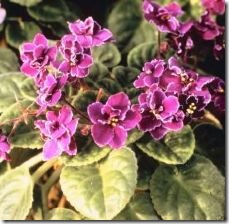African violets are native to a small, localized highland region in tropical East Africa. While 20 species exist, the plants most often sold and grown as houseplants are hybrids or derivations of the species Saintpaulia ionantha. Plant lovers admire African violets for their petite clumping growth habit — a rosette of leaves — and production of attractive, dainty flowers. African violets multiply by vegetative means and sexually with the production of seeds.
Vegetative Plantlets
-
African violets grow from small rhizomes, which are root-like underground stems that store carbohydrates. As the plant grows, the rhizomes elongate and create more roots to absorb water and nutrients for sustenance. Sometimes the growing rhizomes branch off and the tips of the rhizomes reach the soil’s surface. A new plantlet arises, and is a genetic clone of the mother plant. If you look at the base of a mature African violet, you may see miniature plants popping up from the base of the rosette of leaves. Plantlets also arise from the base of a leaf stem. This vegetative, non-sexual, reproduction increases the size of an African violet to become a cluster of plants.
Seed Production
-
African violets also multiply in number through production and germination of seeds. Flowers contain both male and female organs, but within each blossom, pollen is shed before the nearby female pistil is ready. This ensures pollen from other flowers causes fertilization. Pollen is transferred among flowers by wind, splashing water or movement by various insects or animals. Seeds that develop result from the fusion of DNA and the resulting plants never are exactly the same as the parent plant. Seeds germinate in moist soil or compost wherever they land from the parent African violet.
Garden Propagation
-
While pollinating flowers leads to potentially new flowering colors or ornamental features of African violets, most propagation in the garden is done through leaf cuttings. Plantlets that develop on the leaf stem base may be cut off and encouraged to root and further grow in a tray of moist potting media. Or, leaf blade cuttings will differentiate tissues and develop roots if nudged into moist soil. These asexual means of propagation ensure that the plants that develop are similar in ornamental qualities as the parent African violet.
Growing Conditions
-
If an African violet is not growing in good health, both vegetative and sexual propagation is limited or absent. For a vigorous plant, grow it in a humus-rich potting soil that is evenly moist. High ambient humidity and temperatures in the range of 60 to 80 degrees Fahrenheit creates the ideal growing environment. African violets do not cope well with intense, direct sun rays, so place them where they receive bright indirect light. Day length at or more than 12 hours encourages flowering.


Deprecated: strpos(): Passing null to parameter #1 ($haystack) of type string is deprecated in /home/agriviek8Qv/agriviet.net/public_html/wp-includes/comment-template.php on line 2522